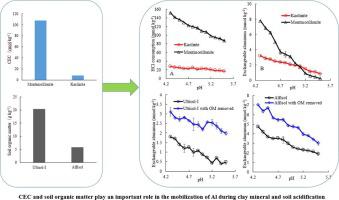Geoderma ( IF 6.1 ) Pub Date : 2022-04-01 , DOI: 10.1016/j.geoderma.2022.115853 Ke-wei Li 1, 2 , Hai-long Lu 1 , Jackson Nkoh Nkoh 1 , Zhi-neng Hong 1 , Ren-kou Xu 1, 2

|
Soil acidification is an increasing challenge to food security due to the production of free aluminum ion (Al3+) that is toxic to crops. The production of exchangeable Al3+ in soils during acidification is a complex process and its specific mechanism is not clear. In this study, kaolinite, montmorillonite, and three acidic soils (two Ultisols and one Alfisol) were used to investigate the changes in exchangeable and soluble Al with pH using a constant pH automatic potentiometric titrator. The effect of soil organic matter (SOM) on soil pH and Al change was also investigated. The results showed that montmorillonite consumed more acid than kaolinite under the same conditions, which were consistent with the larger cation exchange capacity (CEC) of montmorillonite than kaolinite. When the pH was adjusted from 4.8 to 4.3, the exchangeable Al of montmorillonite was significantly higher than that of kaolinite. This was consistent with their CEC and indicated that montmorillonite adsorbed more H+ than kaolinite at the same pH, resulting in more exchangeable Al on its surface. Besides CEC, SOM shows a significant effect on acid buffering capacity and Al activation of acid soils. When acidified to the same pH, the content of exchangeable Al in Alfisol was larger than that in Ultisols. This observation was consistent with the larger CEC and smaller organic matter content of Alfisol. The presence of more organic matter in the Ultisols not only improved their acid buffering performance, but also inhibited the production of exchangeable and soluble Al. In conclusion, CEC of soils and minerals play an important role in soil acid buffering performance. While, SOM not only improves soil acid buffering performance, but also inhibits the mobilization of soil Al.
中文翻译:

土壤和矿物酸化过程中受土壤有机质影响的铝迁移:恒定 pH 值研究
由于产生对农作物有毒的游离铝离子 (Al 3+ ),土壤酸化对粮食安全的挑战越来越大。可交换Al 3+的生产土壤酸化过程是一个复杂的过程,其具体机制尚不清楚。在这项研究中,使用高岭石、蒙脱石和三种酸性土壤(两种 Ultisol 和一种 Alfisol)使用恒定 pH 自动电位滴定仪研究可交换性和可溶性铝随 pH 值的变化。还研究了土壤有机质 (SOM) 对土壤 pH 值和 Al 变化的影响。结果表明,在相同条件下,蒙脱石比高岭石消耗更多的酸,这与蒙脱石比高岭石具有更大的阳离子交换容量(CEC)一致。当 pH 值由 4.8 调至 4.3 时,蒙脱石的可交换铝显着高于高岭石。这与他们的 CEC 一致,表明蒙脱石吸附了更多的 H +与相同 pH 值的高岭石相比,在其表面产生更多可交换的铝。除 CEC 外,SOM 对酸性土壤的酸缓冲能力和 Al 活化有显着影响。当酸化到相同的pH值时,Alfisol中可交换Al的含量大于Ultisol中的。这一观察结果与 Alfisol 较大的 CEC 和较小的有机质含量一致。Ultisol中更多有机物的存在不仅提高了它们的酸缓冲性能,而且抑制了可交换和可溶性Al的产生。总之,土壤和矿物质的 CEC 在土壤酸缓冲性能中起重要作用。而 SOM 不仅提高了土壤酸缓冲性能,而且抑制了土壤 Al 的迁移。



























 京公网安备 11010802027423号
京公网安备 11010802027423号